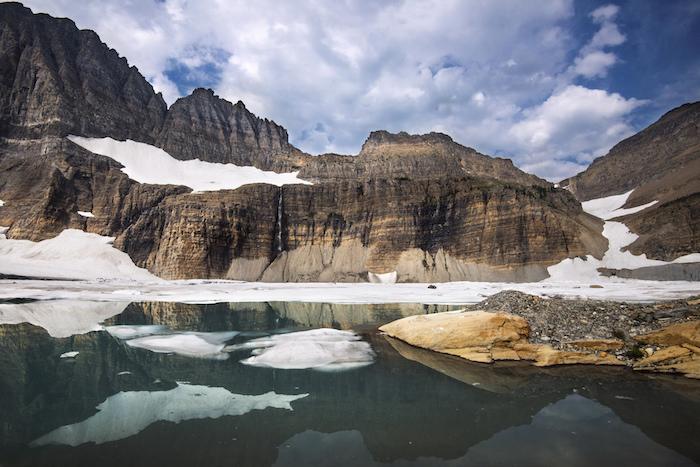
The ice is retreating, but with a good hike you still can see some of Grinnell Glacier/NPS, Tim Rains
Editor's note: Glacier National Park is a hiker's paradise, with more than 700 miles of trails. Jake Bramante has hiked them all -- in one summer! One of his favorites is the hike to Grinnell Glacier. He shared his thoughts on it in our summer guide to the parks.
While today's remnant glaciers interspersed along the peaks of Glacier National Park weren’t responsible for the enormous U-shaped valleys left by their predecessors, their gradual disappearance brings a sort of urgency to see these classic icons.
Six of these glaciers are visible from Going-to-the- Sun Road, if one knows what to look for. Others are visible at a distance with some walking along the trail or from the air. Only two have official trails leading right to their icy fields, Sperry and Grinnell, with the latter being accessible via a wonderful day hike.
While the reason to hike to Grinnell Glacier is the glacier itself, the journey is worth the trip. The trailhead for Grinnell Glacier is well marked and frequently fills up in the summer, so an early start is recommended. The first couple of miles are easy walking through trees and riparian areas, and can be shortened by a couple of lovely boat rides for a fee over Swiftcurrent Lake and Lake Josephine.
The birding in this area is fantastic and moose are frequently spotted in the valley bottom. Once past Lake Josephine, the trail begins gaining elevation, the trees grow sparse, and the views—those wonderful, expansive views—reward you no matter which way you turn.
Keep an eye down the avalanche chutes for moose, the hillsides for bighorn sheep and grizzlies, and the cliffs for mountain goats. Grinnell Lake comes into view with its mint-green color, fed by a waterfall from the glacier above. This otherworldly color is due to rock ground into a powder by glaciers, which stays suspended in the lake, playing with the light, giving it its surreal color.
Eventually, the trail climbs high up into the basin housing the glacier; actually, glaciers. Grinnell Glacier once filled the entire basin, but has receded to the south end. Another piece of its former, large self sits on a shelf, now called Salamander Glacier. What is left behind is a rocky moonscape and a young lake called Upper Grinnell Lake, which is even more green and milky than its downstream neighbor.
Helpful books: This High, Wild Country, A Celebration of Waterton-Glacier International Peace Park, by Paul Schullery



Comments
This area of the park around Many Glacier has some great trails, including the one to Grinnel Glacier descibed in this story. If you don't have the time or stamina for the hike to the glacier, a shorter and easier option in the same area is the hike and boat ride combination to Grinnel Lake, which was described in a story on the Traveler last year.